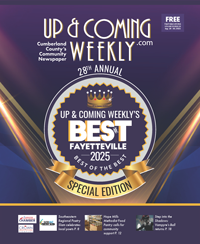- Details
-
Tuesday, 25 November 2025
-
Written by Kirk deViere

I spend a lot of time in neighborhoods across Cumberland County. VFW halls. Coffee shops. Churches. Youth sports fields. Senior centers. Classrooms. And everywhere I go, I meet people who care deeply about their families, their neighbors, their towns and cities. But too often, they do not believe their caring matters. They have stopped expecting their government to listen.
That is the real crisis. Not jobs. Not investment. It is about whether people believe this place is theirs. Whether they trust us. Whether they have pride in Cumberland County.
My time in the military taught me something fundamental about leadership. Mission first, people always. Yes, you have to accomplish the mission. But the only way to accomplish any mission that matters is by taking care of your people. When people know you have their back, when they trust you will fight for them, that is when they will walk through walls to get the job done.
That principle guides everything I do as Chairman. Our mission is clear. Build a thriving Cumberland County with strong schools, safe and healthy communities, good jobs, and quality of life. But we will never accomplish that mission by treating residents like obstacles to work around. We accomplish it by putting people first.
When I became Chairman, I knew we had to rebuild that foundation. Person by person. Neighborhood by neighborhood. Because you cannot legislate pride into existence. You cannot mandate trust. Those things grow from real relationships between real people who show up for each other consistently.
So that is what we have been doing. My job is not just leading the Board of Commissioners as Chairman. It is knowing the volunteer who runs the food pantry, the veteran organizing cleanups in his neighborhood, the teacher fighting for her students, the small business owner investing in their community, the healthcare provider caring for our families. It is remembering their names, following up on their concerns, celebrating their wins. Mission first, people always.
And here is what happens when you approach governing that way. People start believing again. Not in grand promises or political rhetoric, but in the simple truth that someone is actually listening.
We have made transparency the cornerstone of everything we do. When we tackle major challenges, we do not just announce decisions. We bring residents along through every step, share the data and reports we are working from, explain what we are considering and why. Not after the fact, but during the process when their input can actually shape the outcome.
That openness is not easy. It means admitting when we do not have all the answers. It means being accountable when we fall short. But it is the only way to earn trust. And trust is everything. Just like in the military, when your people trust you are working for their best interests, they become your strongest allies in accomplishing the mission.
When people trust their government, something remarkable happens. They start taking pride in their community again. They pick up trash in their neighborhoods. They support local businesses. They show up to meetings. They volunteer. Pride becomes contagious.
We have focused relentlessly on what people can see and feel in their daily lives. Parks that are clean and safe. Neighborhoods that feel cared for. Water that is safe and clean. Schools our children deserve.
Healthcare people can access when they need it. A hand up for people in need. Jobs that let families build a future here. Events that celebrate our incredible diversity and military heritage. These are not just line items in a budget. They are investments in people’s ability to take pride in where they live.
And I see that investment growing every day. More people at public meetings. More volunteers for community projects. More families choosing to stay. More pride in being from Cumberland County.
This is happening because people are choosing to engage, because they believe it matters, because they trust we are building something real together.
The beautiful thing about pride is how it multiplies. When residents believe in their county, they become our best ambassadors. They tell their military friends to retire here. They convince their kids to come back after college. They brag about Cumberland County to anyone who will listen. That is how you build sustainable growth. Not through marketing campaigns, but through genuine pride that spreads from person to person.
We are not there yet. Not every neighborhood feels this shift. Not every resident has seen the change. But we are building it, step by step, decision by decision, relationship by relationship
My commitment to you is simple. We are going to keep showing up. We are going to keep listening before we decide. We are going to keep making decisions with you, not for you. Mission first, people always. That is not just a saying. It is how we govern.
The Cumberland County we are building is not about impressing outsiders. It is about the people who already live here knowing this place is worth their investment, their hope, their pride.
Together, we build trust. Together, we build pride.
(Photo: Downtown Fayetteville lit up at night. Photo courtesy of City of Fayetteville's Facebook page)

 I spend a lot of time in neighborhoods across Cumberland County. VFW halls. Coffee shops. Churches. Youth sports fields. Senior centers. Classrooms. And everywhere I go, I meet people who care deeply about their families, their neighbors, their towns and cities. But too often, they do not believe their caring matters. They have stopped expecting their government to listen.
I spend a lot of time in neighborhoods across Cumberland County. VFW halls. Coffee shops. Churches. Youth sports fields. Senior centers. Classrooms. And everywhere I go, I meet people who care deeply about their families, their neighbors, their towns and cities. But too often, they do not believe their caring matters. They have stopped expecting their government to listen.
 How to resolve AdBlock issue?
How to resolve AdBlock issue? 











